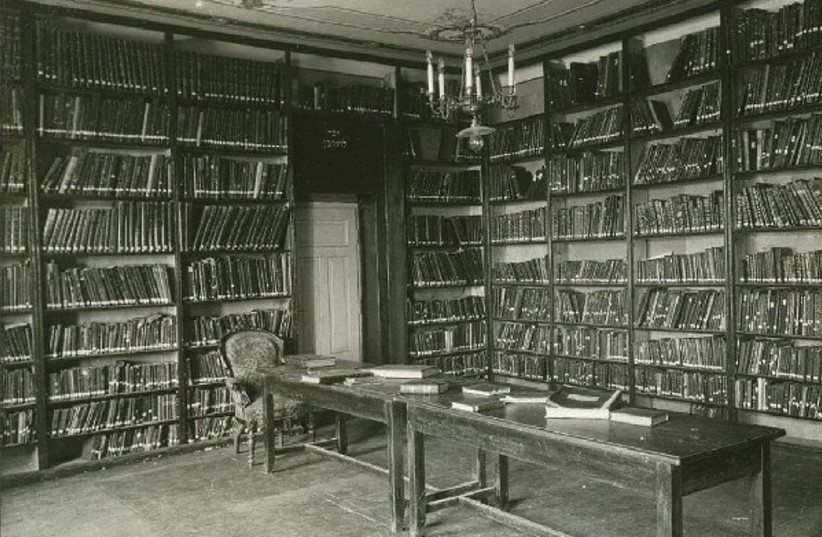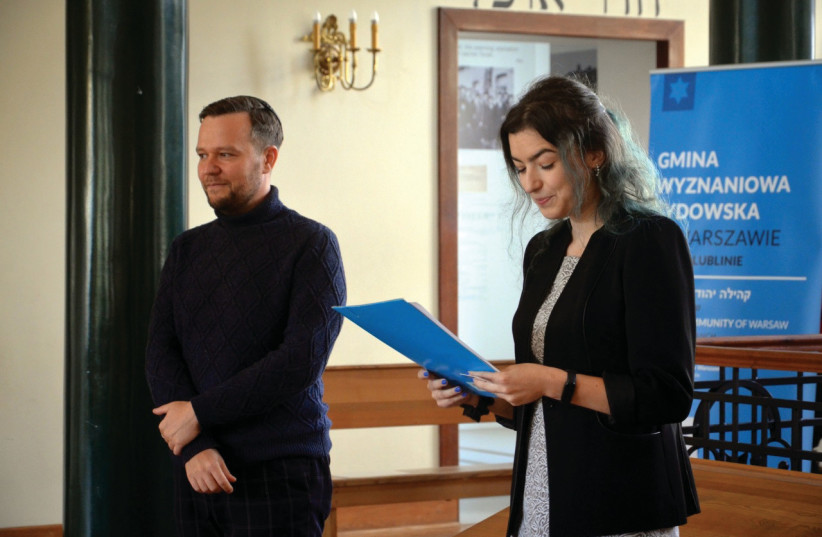It was said to be one of the Jewish gems of Eastern Europe. A library containing thousands upon thousands of valuable books, manuscripts, and scrolls was one of the prized jewels of the Chachmei Lublin Yeshiva (Academy of the Sages of Lublin) in Lublin, Poland.
When the Nazis took over the city a few weeks after the outbreak of World War II, in September 1939, this priceless treasure trove of Jewish knowledge fell into German hands. A few months later, the library was ransacked and its contents burned in front of the yeshiva in a great bonfire. One witness allegedly said that a brass band stood on the yeshiva’s steps and played as the flames engulfed the books, reducing that magnificent library to cinders and ash.
Except that it never happened.
The story of the Chachmei Lublin Yeshiva library entered post-war Jewish folklore as a lost treasure of pre-Holocaust Eastern European Jewry. Over the past few years, more and more of its valuable books have been discovered worldwide. So, what is the real story?
The Chachmei Lublin Yeshiva was founded by the famed Rabbi Meir Shapiro, who introduced the Daf Yomi (the learning of one page of Talmud daily) to the Jewish world. Open from 1930-1939, the yeshiva was one of the largest in the world.

“Rabbi Shapiro wanted to create in Lublin the best, the most renowned, the most modern yeshiva, and such a yeshiva requires an equally huge and rich library,” researcher Piotr Nazaruk told the Magazine. “His goal was to collect at least 100,000 books, which, of course, never happened because the yeshiva existed for only nine years.” Nazaruk works at the Grodzka Gate-NN Theater Center, a city institution dedicated to the preservation of Lublin’s heritage.
Donations to the library came from far and wide. Rabbi Benjamin Gut of the Chasam Sopher Synagogue in New York reportedly donated $1,000 and as many as 4,000 books. When Shapiro died in 1933, his own vast personal collection was added to the library.
“The yeshiva collected maybe 30,000 volumes thanks to donations from the Jewish world,” Nazaruk explained.” Committees were formed in various cities in Poland, as well as around the world. It was easily one of the largest religious libraries in Poland; from what we know, not only did it have a huge collection but also a very valuable one. Some of its books dated from the first half of the 16th century, among the earliest Jewish books in print.”
The widespread belief in the Nazi destruction of the library seems to have stemmed from an ostensible February 1940 report in an unknown German newspaper, Die Deutsche Jugend-Zeitung, stating that the library books were thrown out of the building and burned in a fire that lasted for 20 hours. This is the source that is regularly used when retelling the library’s story, even though no such Nazi publication seems to have existed. The story was then repeated a year later, in January 1941, by the British Mandate-era Palestine daily HaTzofe and, from there, became folklore.
“The post-war history is extremely convoluted,” Nazaruk told the Magazine. “There is this popular legend that the Germans in 1940 burned the entire collection in front of the yeshiva. The problem is that it is based on a quote from a German newspaper that probably never existed, and it is also contradicted by German documents created during the war, as well as post-war documents.
“These state that the Nazis looked at the entire collection and transferred all the books to the main Lublin Library. They actually hired a rabbi, Aron Lebwohl, a known yeshiva graduate, to make a catalog of the entire collection.”
Lebwohl worked on the cataloging until his murder in the gas chambers of Majdanek in November 1942. His catalog remains undiscovered.

FOR NAZARUK, the Nazis’ documenting and cataloging of these priceless volumes is proof that they never burned the collection, or at least the majority of it. The aim, it appears, was to transfer the works back to Germany or to some other location in the Thousand-Year Reich, to document the history of the extinct race of Jews.
“If the Germans wanted to do something with the collection, such as transfer it to Germany, they didn’t have time. They just left it when Lublin was liberated in the summer of 1944. The entire collection was in Lublin until 1946, when it was transferred to Warsaw, to the Central Jewish Historical Commission, which then became the Jewish Historical Institute,” Nazaruk explained.
After the war, he claimed, articles existed in Yiddish, English, and Hebrew, explicitly stating that the library had survived the destruction but was apparently forgotten. One such notice appeared in November of 1944 in the first post-war Jewish Polish newspaper, Bulletin of the Jewish Press Agency, which read, “While fleeing, the Germans left crates in Lublin... Now an organized effort to collect and sort out Jewish books has begun. About 80,000 volumes have been collected so far. The Ministry of Education has taken charge of all the rescued volumes, among which is also the library of Chachmei Lublin.”
Post-war communist Poland was not a particularly welcoming place for Jews, despite the horrors of the Holocaust. Many thousands returned from concentration camps to find themselves unable to rebuild their lives; their property had been stolen and the authorities less than welcoming. Thousands of surviving Jews fled Poland in the early years after World War II, and the library’s story seems to have become an afterthought.
“For many, many decades, libraries were not doing provenance research. It is only now that they started looking into [the] stamps in books in their holdings, to map where the books have actually come from,” Nazaruk explained. “The collection of the yeshiva is just a drop in the ocean.
“These books were just sitting in library warehouses, but it is the digitization of collections that has brought them back to the surface.”
NAZARUK’S PERSONAL adventure with the Chachmei Lublin Yeshiva Library started four years ago when he chanced upon the discovery of some 130 books in the collection of the Jewish Historical Institute in Warsaw. Before this finding, only five books from the yeshiva’s library were known. These five were discovered by chance in 2006 in the Chewra Nosim Synagogue in Lublin, but how the books found their way there appears unknown. Another five books were returned recently to Lublin thanks to the ongoing project to find and digitize the yeshiva’s collection. In 2022, two volumes were found and recovered from the Freie Universitaet of Berlin, and three volumes were found in a private Israeli collection.
Nazaruk recalled that his initial discovery “was by chance.”
“I was sitting in my office, and it was late afternoon, and I was checking out the [Institute’s] digital library. Usually, I do research in Yiddish because that is my main interest. For some reason, however, I decided to check the digital holdings of Hebrew prints at the Jewish Historical Institute. Suddenly, I see a digitized book with the stamp of the Chachmei Lublin Yeshiva – completely by chance.
“It was amazing,” Nazaruk said. “I spent all evening browsing all the books they had online, and suddenly we knew about 130 more books.”
Through painstaking research in local libraries, private collections, the Jewish Historical Institute, and the National Library of Israel, almost 900 volumes bearing the stamps of the yeshiva have been found and digitized.
“It’s often like detective work,” Nazaruk said. “Sometimes, it’s an extremely boring activity because if you have thousands upon thousands of books to check, it can be frustrating; but when you succeed, it is an amazing feeling. Just a few weeks ago, together with my colleagues, we actually traveled to a Catholic seminary, where we found two books with yeshiva stamps. It shows you can find such books even in places like Catholic seminaries, which is absurd.”
The six-story building that was, for a few short years, a center of European Jewish learning still stands in Lublin today with its yellow facade. Unfortunately, the Jewish community was not so lucky. Of what was once a thriving Jewish community, up to 40,000-strong, only some 40 members remain today – a stark reminder of the horrors inflicted upon Polish Jewry.
The Lublin community seems determined to keep alive the memory of what was once a thriving society. This Friday, a ceremony will commemorate 100 years since the cornerstone of the yeshiva was placed, in May 1924.
A permanent exhibition about the library, including 10 never-before-exhibited yeshiva library books, will be on display, along with an old-fashioned library card catalog, identifying books with Lublin Yeshiva stamps that currently reside in various institutions in Israel, Poland, and the US.
As for the future of this precious treasure trove of Jewish history, who knows where in the world the next books will turn up?
Nazaruk told the Magazine that he is “highly dependent on the help of others” in his mission to restore the lost collection.
“It is amazing when I open my email and find a message from yeshiva students from Israel or across the world sending me photos of books they have.
“It is extremely interesting to map how a book ended up in a local library or yeshiva and then traveled somewhere. Who was the previous owner? Who was the owner after the war? This is something I find fascinating. The journey of books.”
Yeshivat Chachmei Lublin’s most famous sons
Rabbi Meir Shapiro (1887-1933) – Prominent Polish hassidic rabbi and rosh yeshiva, also known as the Lubliner Rav, is noted for his promotion of the Daf Yomi study program in 1923, and establishing the Chachmei Lublin Yeshiva in 1930.
Between 1922 and 1927, Shapiro was the first Orthodox Jew to become a member of the sejm (parliament) of the Second Polish Republic, representing the Jewish minority of the country.
Yehiel De-Nur (1909-2001) – Jewish writer and Holocaust survivor, whose books were inspired by his time as a prisoner in the Auschwitz concentration camp.
Yehuda Meir Abramowicz (1914- 2007) – Israeli rabbi and politician who served as general secretary of Agudat Yisrael, which he represented in the Knesset from 1972-1981, and as deputy speaker of the Knesset between 1977-1981. One of his lasting contributions to Israeli society was the introduction of legislation requiring drivers of vehicles to wear seat belts.
Pinchas Hirschprung (1912-1988) – Polish-Canadian rabbi, posek (legal scholar who determines the application of Halacha), and rosh yeshiva, who served as chief rabbi of Montreal from 1969 until his death.
Yona Sztencl (1904-1969) – Orthodox rabbi who founded the daily Jewish learning cycles of Mishna Yomis and the Halacha Yomis. Also served as the rabbi of Congregation Bais Hassidim Arlenger in Tel Aviv and was a member of the Chief Rabbinate of Tel Aviv.
Shmuel HaLevi Wosner (1913 – 2015) – Prominent Ashkenazi rabbi and posek living in Bnei Brak. He was known as the Shevet HaLevi, after his major work. – A.W.
